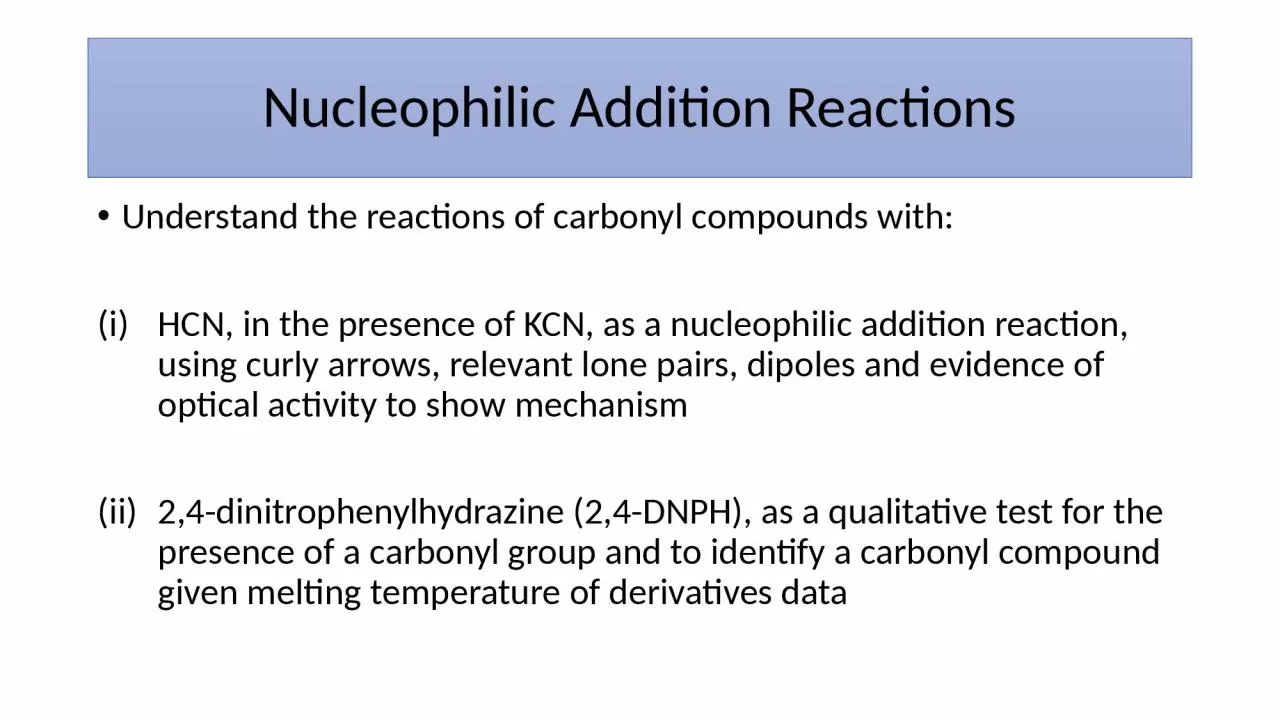

Understand the reactions of carbonyl compounds with HCN in the presence of KCN as a nucleophilic addition reaction using curly arrows relevant lone pairs dipoles and evidence of optical activity to show mechanism ID: 934306
Download Presentation The PPT/PDF document "Nucleophilic Addition Reactions" is the property of its rightful owner. Permission is granted to download and print the materials on this web site for personal, non-commercial use only, and to display it on your personal computer provided you do not modify the materials and that you retain all copyright notices contained in the materials. By downloading content from our website, you accept the terms of this agreement.
Slide1
Nucleophilic Addition Reactions
Understand the reactions of carbonyl compounds with:
HCN, in the presence of KCN, as a nucleophilic addition reaction, using curly arrows, relevant lone pairs, dipoles and evidence of optical activity to show mechanism
2,4-dinitrophenylhydrazine (2,4-DNPH), as a qualitative test for the presence of a carbonyl group and to identify a carbonyl compound given melting temperature of derivatives data
Slide2What do you think you will make…
CH
3
CH
2
CHO + HCN
?
CH
3
COCH
2
CH
3
+ HCN ?
What do you think they are called?
Slide3What do you think you will make…
CH
3
CH
2
CHO + HCN
CH
3
CH
2
CH(OH)CN
CH
3
COCH
2
CH
3
+ HCN
CH
3
C(CN)(OH)CH
2
CH
3
2-hydroxybutanenitrile
2-hydroxy-2-methylbutanenitrile
Slide4Nucleophilic Addition Mechanism
Slide5Nucleophilic Addition Mechanism
Slide6Why can it make a racemic mixture?
C=O is planar
Step 1
equal chance of attacking from each side of the plane
Equal amounts of dextrorotary and laevorotatory enantiomers
No optical activity
Slide7Slide8Questions
Show the reaction of
methanal
and hydrogen cyanide
Name the organic product
Show the reaction of propanone and hydrogen cyanide
Name the organic product
Slide9Exam Question
Slide10Slide11The reaction with 2,4-dinitrophenylhydrazine
Brady’s reagent
2,4-DNPH
Do not need to know equations or mechanisms for any reaction involving this reagent
Useful to know the structure, and the structure product of its reaction with a carbonyl compounds
Slide12Slide13Melting temperature of derivatives
Carbonyl Compounds
Boiling Temperature (°C)
Melting
temperature of 2,4-dinitrophenylhydrazone derivative (
°C)
Pentanal
102
104
Pentan-2-one
102
144
Pentan-3-one
102
156
What can you conclude from this data?
Slide14Derivatives
Compounds formed known as derivatives
Filtered, purified and dried
Melting temperatures measured
Derivatives have the ending ‘-one’
E.g. derivative of
butanal
is
butanal
2,4-dinitrophenylhydrazone
Can compare the experimental values to identify the original carbonyl compound
Match melting temperature to data book
Slide15Exit Pass
Compound X reacts with 2,4-dinitrophenylhydrazine and with iodine in aqueous alkali in separate tests. In both cases a coloured precipitate is formed.
Explain which of these could be compound X:
Propanal
Propan-1-ol Propan-2-ol Propanone